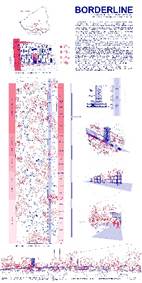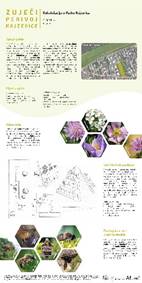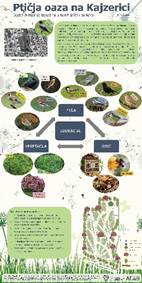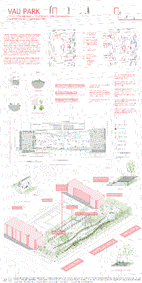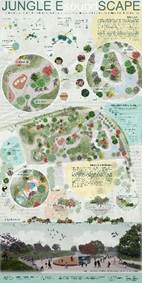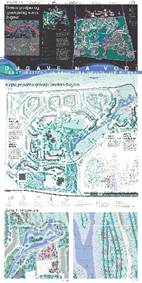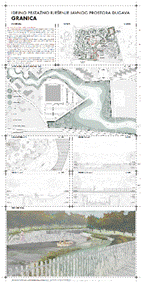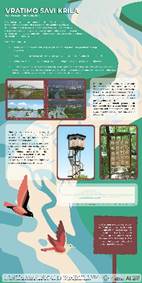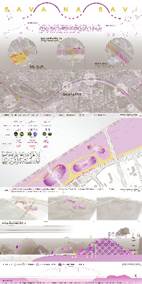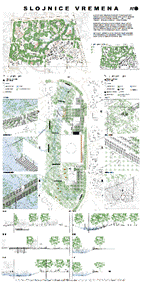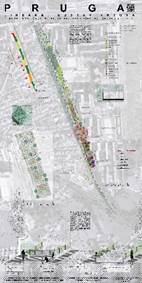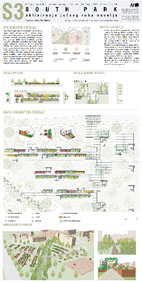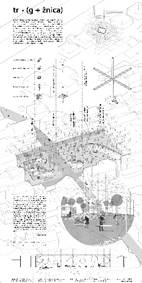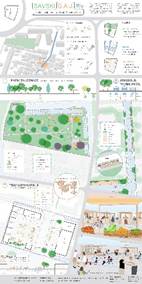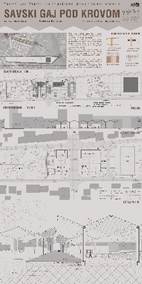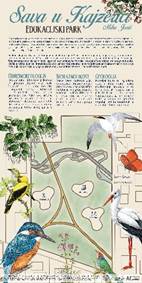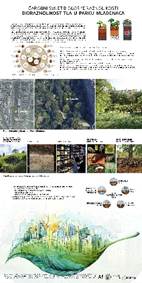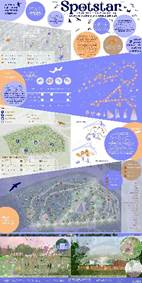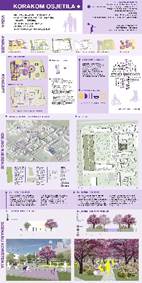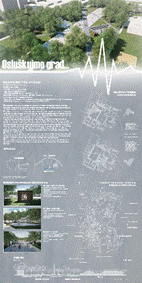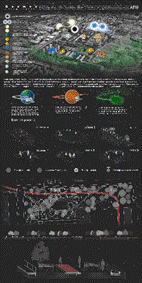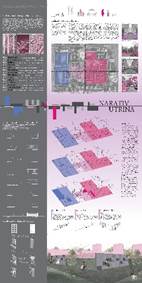Urban ecology within multidisciplinary educative framework
|
Teaching (Today for) Tomorrow: Bridging the Gap between the Classroom and Reality 3rd International Scientific and Art Conference
|
|
Tamara Zaninović1, Ana Sopina2, Bojana Bojanić Obad Šćitaroci3, Vesna Gulin Beljak4, Mirela Sertić Perić5University of Zagreb Faculty of Architecture1,2,3, Croatia University of Zagreb, Faculty of Science4,5, Croatia tmaric@arhitekt.unizg.hr |
|
| Section - Education for sustainable development | Paper number: 35 |
Category: Preliminary communication |
Abstract |
|
Urban ecology explores how living organisms, including humans, interact with each other and their environment in urban settings. It is an interdisciplinary field that connects biology, urban planning and other disciplines. This paper presents how urban ecology topics are integrated into educative framework of University of Zagreb through the methodology and results of collaboration between students and teachers of two faculties (Faculty of Science, Department of Biology, and Faculty of Architecture, Department of Urban Planning, Spatial Planning, and Landscape Architecture) of the University of Zagreb. This collaboration demonstrates the successful application of a multidisciplinary approach in teaching and learning, evolving into an inter- and transdisciplinary approach, underlining its importance in addressing the pressing challenges of sustainable urban development. The collaboration began in the 2020/2021 academic year with the introduction of the Urban Ecology elective as part of the Master’s degree programme in Environmental Sciences at the Faculty of Science, and linking its content with the Design Studio III – Landscape Architecture course, an integral compulsory component of the Bachelor's degree programme in Architecture. Over the course of four academic years (2020 - 2024), the teaching methodology evolved through the integration of multidisciplinary lectures and participatory efforts that involve local communities in the students' project development process. Students' projects focus on different sites within a common urban context, such as the New Zagreb neighbourhoods - an outstanding example of modernist and post-modernist urban planning in Zagreb, Croatia. The results of the student projects show the importance of integrating urban/landscape design and ecological solutions. The projects have demonstrated how such integration can improve urban liveability and sustainability. The success of this collaborative framework is in line with the Sustainable Development Goals and highlights the value of a multi-, inter- and transdisciplinary approach to planning sustainable urban solutions. |
|
Key words: |
|
interdisciplinary; exhibitions; project-based learning; public space; Zagreb |
Introduction
UN reported that 57% of the world’s population lives in urban areas and projected the growth of that percentage in the future (UNCTAD, 2023). This means that cities as main urban areas are becoming even more complex ecosystems and habitats. The challenges posed by increasing urbanization – ranging from environmental degradation to social inequality – demand innovative, integrated approaches to research and teaching (Rieckmann, 2018). Addressing these issues requires a more extensive application of multi-, inter-, and transdisciplinary methods, which can provide holistic solutions that span across disciplines and scales (Scholz et al., 2006; Lehmann, 2010).
The terms multidisciplinary, interdisciplinary, and transdisciplinary all describe collaborative efforts involving multiple disciplines, yet they vary in their scope and depth of integration. These concepts arise from the need to overcome the artificial fragmentation of knowledge into distinct fields, but they do not carry the same meaning (Park & Son, 2010). The differences lie in how they influence the collaboration and integration of expertise from various disciplines, shaping the way professionals work together.
To clarify, the following definitions are commonly accepted:
• Multidisciplinarity refers to drawing knowledge from different disciplines, but each discipline retains its own boundaries. The disciplines work side by side, providing their perspectives on a common theme without significantly overlapping (NSERC, 2004).
• Interdisciplinarity goes a step further by analysing, synthesizing, and harmonizing links between disciplines to create a coordinated and coherent whole. It integrates the knowledge and methods of multiple disciplines to provide a more comprehensive understanding (CIHR, 2005).
• Transdisciplinarity transcends the boundaries of individual disciplines and integrates knowledge from the natural, social, and health sciences in a humanities context, aiming to solve complex, real-world problems through collaborative, holistic approaches (Soskolne, 2000).
These definitions can be understood as a spectrum, with multidisciplinarity representing the most basic level of integration, interdisciplinarity offering deeper connections and synthesis, and transdisciplinarity embodying the most advanced, holistic integration that involves active problem-solving through combined expertise.
Urbanization’s rapid pace, especially in the context of global environmental changes, calls for a rethinking of how urban spaces are planned, managed, and inhabited. At the same time, these challenges are deeply interconnected with the achievement of the Sustainable Development Goals (SDGs), particularly those related to sustainable cities and communities (SDG 11), climate action (SDG 13), and life on land (SDG 15) (Sachs, 2015; Creutzig et al., 2024).
The integration of biological, ecological, planning, urban, and architectural knowledge is vital in addressing the complex problems of urbanization, where sustainable, human-centred, and ecologically sound solutions must be co-created (Elmqvist et al., 2013; McPhearson et al., 2018). This interdisciplinary collaboration is essential in promoting the well-being of both humans and non-human species in urban environments (Karaman, 2022). Urban parks, for example, are a critical component of green infrastructure that can support biodiversity, enhance resilience to climate change, and provide social spaces that foster community engagement (MA, 2005; Ahmed Eleva, 2019).
At the University of Zagreb, Croatia, the research and design projects developed by students embody this collaborative approach, merging insights from the Faculty of Science (Department of Biology) and the Faculty of Architecture (Department of Urban Planning, Spatial Planning and Landscape Architecture). These projects encourage students to tackle the multifaceted challenges of urbanization by drawing on the expertise of both fields. Since 2020, the collaborative efforts between the two faculties have been increasingly shaped by courses such as the elective Urban Ecology at the Faculty of Science, as part of the Master’s degree program in Environmental Sciences, and Design Studio III – Landscape Architecture a compulsory course at Bachelor’s degree program in Architecture and Urban Planning at the Faculty of Architecture.
The courses, held separately within the two faculties, have now evolved into a cohesive platform for interdisciplinary and transdisciplinary research and teaching, driven by the collaborative efforts of faculty members across both institutions. These courses reimagine urban public spaces in Zagreb as multi-functional community places that serve the needs of diverse living beings. Students engage with these real-world complexities through case studies that incorporate ecological, social, and design perspectives.
The aim of this work is to present how students and teachers from the Faculty of Science and the Faculty of Architecture at the University of Zagreb collaborate to investigate the complexity of urban public spaces. Through this work, we aim to showcase the successful application of a multidisciplinary approach, evolving into an interdisciplinary and transdisciplinary one, and highlight the importance of such collaborations in addressing the urgent challenges of sustainable urban development.
Methods
Urban ecology and Design Studio III – Landscape Architecture courses: formative years of collaboration
The interdisciplinary collaboration at the University of Zagreb began in the 2020/2021 academic year with the introduction of the elective course Urban Ecology as part of the Master’s degree programme in Environmental Sciences at the Faculty of Science, Department of Biology. This course aimed to equip students with the skills to assess the impact of urbanization on ecosystems, propose strategies to mitigate its negative effects, and evaluate the influence of global environmental changes on urban systems. The course culminates in a seminar paper, which may take the form of a grant application proposal. During its first year, the course adopted a multidisciplinary approach, incorporating subjects such as ecology, geophysics, hydrology, landscape architecture, environmental social sciences (environmental economics), and energy efficiency.
The Design Studio III – Landscape Architecture course is a required component of the undergraduate program (third year) in Architecture and Urban Planning. The course includes weekly workshops, with groups of 12-16 students led by a team of eight teachers from the Department of Urban Planning, Spatial Planning, and Landscape Architecture. The final student projects within this course are presented in two forms: a booklet and a poster. The booklet combines theoretical insights on public space and contemporary landscape architecture with documentation of the design process, including concept studies, models, and design variants. It tells the story of how the students' proposals evolved, encouraging them to appreciate the research and iterative nature of design. This comprehensive approach to project presentation not only showcases the final solution but emphasizes the process, fostering a research-oriented climate in the course.
Expansion of the collaborative teaching approach through students’ assignments and projects
From the 2021/2022 academic year onward, the collaboration between the two faculties and courses deepened, particularly through student assignments that merged the expertise of both faculties (coordinated by authors of this paper). This phase saw the integration of urban design principles with biodiversity conservation, as students engaged in project-based learning focused on enhancing public spaces and improving the quality of life in Zagreb.
In students’ projects, ecological principles were blended with urban design strategies to propose innovative solutions for revitalizing public spaces (e.g., urban parks, squares, playgrounds, streetscapes, waterfronts, markets) in several neighbourhoods in the southern part of Zagreb (New Zagreb area including neighbourhoods Zapruđe, Utrina, Travno, Dugave, Sopot, Siget, Trnsko, Savski gaj, Kajzerica, Lanište). These areas are characterized by fragmented public spaces, limited integration of nature within urban environments, and growing concerns about sustainability. Moreover, the neighbourhood’s unique combination of modernist residential blocks, expansive green spaces, and transportation networks provides an ideal setting for reimagining urban spaces that integrate ecological principles with design thinking.
The interdisciplinary nature of the collaboration became especially evident in the merging of student groups from the Urban Ecology course at the Faculty of Science and the Design Studio III – Landscape Architecture course at the Faculty of Architecture. This collaborative model emphasized the importance of combining ecological knowledge with landscape design thinking, encouraging students to work across disciplines and develop holistic solutions for urban renewal and sustainability. By working together across faculties and disciplines, students learn to tackle the complexities of urban transformation and contribute to the realization of sustainable, inclusive, and vibrant urban spaces.
Project-based teaching and learning
The interdisciplinary approach in our work is implemented through a blend of lectures, practical exercises, and collaborative student projects. Core and guest lecturers provide students with crucial knowledge in urban ecology, landscape architecture, and urban planning principles, enabling them to understand the broader contexts in which these fields intersect. Practical exercises help students apply this theoretical knowledge to real-world scenarios, fostering dynamic group discussions with experts and guest critics. These interactions promote critical thinking, collaboration, and interdisciplinary problem-solving as students explore the intersection of biodiversity conservation, urban development, and public space design.
The project-based structure of the courses encourages students to take ownership of their learning (Guo et al., 2020) by working on actual urban interventions. They present their work through seminar papers, research projects, and oral presentations, which further enhance collaborative learning, peer feedback, and knowledge exchange. Joint public exhibitions are organized to showcase student projects to the local community, offering a platform for engagement and feedback on proposed urban interventions. This participatory aspect highlights the importance of community input, ensuring that student proposals are grounded in local needs and realities.
Student assignments are organized in a series (cycles/set/sequence), where in consecutive academic year the focus is shifted on different sites but relating to a common urban context. For instance, the assignments within the New Zagreb neighbourhoods serve as a case study throughout the course, with each year focusing on different areas. Students work in pairs, developing their teamwork skills, and select a site from a set of proposed locations to develop their project proposal.
Over the past three academic years (2020/2021 to 2023/2024), teaching methodology has evolved through the integration of multidisciplinary lectures and mentoring, alongside participatory efforts to involve local communities in the project development process. The overarching theme for student assignments during this period has been “Rethinking and (Re)Designing Open Public Spaces in New Zagreb”. Each academic year focused on a different part of New Zagreb, with the spatial focus shifting to four different neighbourhoods each time.
As visible from Fig. 1, in the first year, the focus was on New Zagreb East, where four neighbourhoods – Zapruđe, Utrina, Travno, and Dugave – were considered for the wider context, with students selecting specific sites for their project design. For the Urban Ecology students, the Dugave area was chosen. In the second year, the focus shifted to New Zagreb South, where six sites were selected by the teaching team from over ten areas proposed by local communities. Urban Ecology students worked on a project in Park Mladenaca in Trnsko. Finally, the third year focused on the western part of New Zagreb, with seven sites offered for selection. Urban Ecology students could choose from two sites: the Sava area and the Kajzerica area.
New Zagreb as a living urban laboratory for teaching and learning
The New Zagreb area, located south of the Sava River, developed in the second half of the 20th century and is a significant example of modernist and post-modernist urban planning (Laszowski, 1994; Mlinar & Klasić, 2021). This unique urban context serves as a valuable teaching and learning ground, offering students the opportunity to explore the evolution of cities in the 20th century while addressing current urban challenges. Students critically engage with the area’s history and context through research, discussions, and interdisciplinary collaboration, ensuring their designs are responsive to both historical legacies and contemporary needs.
The assignments throughout the course were structured as a series that collectively examined New Zagreb’s urban landscape from various perspectives. This approach followed a clear spatial and thematic logic, aligned with the city’s urban planning context. Each year, students focused on different parts of the New Zagreb area (Figure 1), working within the following thematic frameworks:
• Heritage Revitalization – New Zagreb East (2021/2022): The theme focused on enhancing and supporting modernist urban heritage. Students re-analyzed and proposed design solutions for neighbourhoods such as Zapruđe, Utrina, Travno, and Dugave, aiming to preserve the modernist character while addressing contemporary urban needs.
• Community Spaces – New Zagreb South (2022/2023): This year’s theme revolved around creating spaces for the community. Students designed urban interventions in areas where neighbourhoods were planning new uses, such as Utrina, Sopot, Siget, and Trnsko. The emphasis was on participatory design, involving local communities in the planning process to ensure that their needs and priorities were reflected in the proposals.
• Slash City – New Zagreb West (2023/2024): The theme in the final year focused on mediating diverse spatial boundaries and finding solutions for public urban systems in morphologically heterogeneous areas, including Trnsko, Savski Gaj, Kajzerica, and Lanište. Students were tasked with addressing the challenges posed by the varied and complex urban fabric of these neighbourhoods.
The selection of sites and the development of assignments were carried out in close collaboration with local communities. This participatory process involved multiple conversations with residents about the challenges and opportunities within their public spaces, ensuring that the proposed changes were deeply rooted in the needs and aspirations of the people who live there.
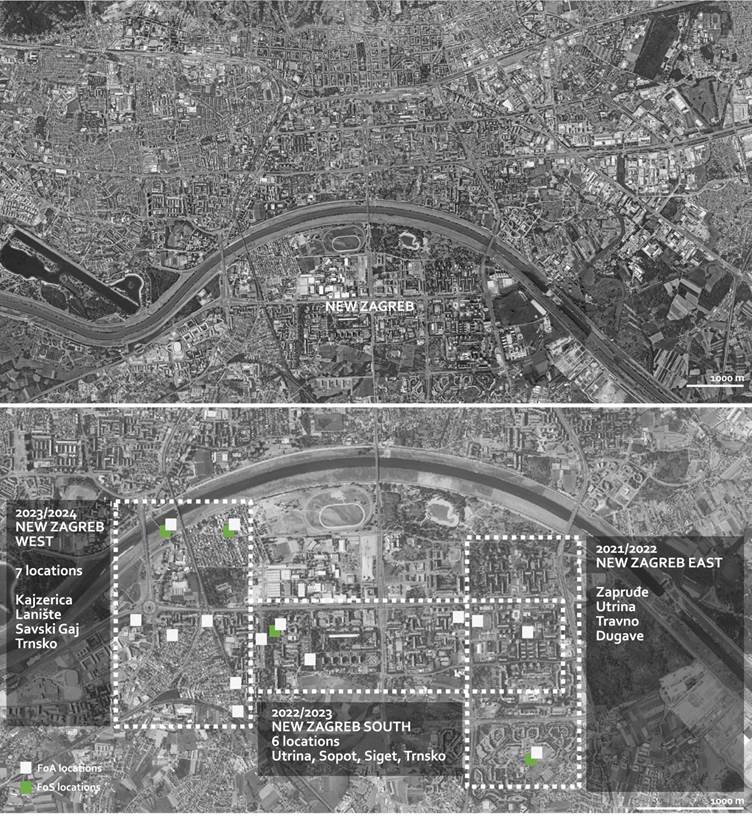
Figure 1
Site locations of student projects assignments from 2021 until 2024 as part of the courses Design Studio III – Landscape Architecture (Faculty of Architecture, FoA) and Urban Ecology (Faculty of Science, FoS)
Student semester structure and organisation: multidisciplinary thematic blocks
The teaching and design/research process in the courses is structured into three thematic blocks (Table 1), each lasting approximately one month during the semester. This structure combines lectures, seminars, workshops, and exhibitions, organized into the following phases:
• Preparatory phase: This initial stage involves meetings with teachers and local communities to define the semester assignment and select locations aligned with the needs of the communities.
• First block: The semester begins with introductory lectures and a guided tour of the selected locations, accompanied by local community members. This provides students with valuable context and insights into the urban challenges they will address.
• Second block: This phase includes research seminars and design studio workshops, where students collaborate with mentors and engage in multidisciplinary lectures. The focus is on developing students' design ideas and exploring diverse approaches to public spaces. Students also review previous project proposals through exhibitions of past student work, which serves as a source of inspiration.
• Third block: The final block involves the culmination of the student projects, including final presentations and critiques from guest critics. Students present their work through posters, which are showcased in a final exhibition. This phase emphasizes the importance of critical feedback and refinement of ideas.
• Post-semester activities: After the semester concludes, students participate in round tables, presentations at fairs, and public exhibitions to promote and disseminate the results of their work. These activities allow students to engage with the broader community and share their findings.
Each block is introduced by a multidisciplinary set of lectures designed to connect various perspectives, including those of designers, architects, biologists, and sociologists. These lectures are also integrated at the end of the semester as guest critiques, fostering an environment of continuous exchange between practice and academia. The interdisciplinary approach further encourages resilience through collaborative learning, and the reciprocal relationship between research and practice creates a dynamic space for experimentation.
Each year, the student projects are showcased in exhibitions that foster discussion and reflection. These exhibitions serve as responsive, interactive platforms, drawing participation from students, mentors, local communities, museums, and the Zagreb Society of Architects (DAZ).
Table 1
Structure and organisation of student semester in multidisciplinary thematic blocks
|
Structure and organisation of semester |
Lectures UE + DS |
Seminar UE (FoS) |
Workshops DS (FoA) |
Exhibitions UE + DS |
|
SEMESTER PREPARATION BLOCK September |
_meetings with teachers and local community |
/ |
/ |
/ |
|
1. BLOCK - CONTEXT October |
_introduction lectures – assignment presentation, urban development _field lectures – teachers and local community |
_ selecting location _definition of research topic _interpretation of good practices |
_selecting location _research of location context _theoretical background _interpretation of project examples |
/ |
|
2. BLOCK – CONCEPT Application of research topics November |
_conceptual lectures – landscape ideas, ecological and social aspects |
_application of research topic within the selected location _project programme |
_concept and programme of wider urban landscape system |
_exhibition of student projects posters from previous academic year |
|
3. BLOCK – DESIGN SOLUTIONS December and January
|
_design lectures – urban design, product design, materials and construction |
_preparation of project seminar _poster finalisation |
_conceptual landscape solution of public space _poster finalisation |
_final presentations with critics _final presentation of project posters |
|
POST-SEMESTER BLOCK |
_round table on results of the New Zagreb series |
/ |
/ |
_public exhibitions in places of local communities and fairs |
Notes: FoS – Faculty of Science, FoA – Faculty of Architecture, UE – Urban Ecology course, DS – Design Studio III – Landscape Architecture
Results
This section presents the outcomes of student projects from the Urban Ecology and Design Studio III - Landscape Architecture courses, which were conducted through a collaborative teaching effort between the Faculty of Science, Department of Biology, and the Faculty of Architecture, Department of Urban Planning, Spatial Planning, and Landscape Architecture at the University of Zagreb, Croatia. Over a period of three years (2021–2024), students engaged in a series of lectures, workshops, and seminars aimed at fostering synergies between urban ecology and urban planning. The projects focused on the development of new open public spaces in selected districts of New Zagreb, Croatia, and demonstrated how integrating landscape design with ecological solutions can enhance the quality of urban life while promoting sustainability. In the 2020/2021 academic year, the collaboration also involved students from the School of Design programme at the Faculty of Architecture (courses Visual Communication 4 and Industrial Design 6). In the 2022/2023 academic year, Agronomy students from the Faculty of Agriculture joined as well with courses from both undergraduate and master studies of the Landscape architecture programme (courses Urban Landscape Design and Studio 1 – Landscape Design). However, since these students participated only partially in the New Zagreb assignments series, their projects are not included in the results of this work. The following results highlight the diverse approaches and innovative solutions that emerged from the interdisciplinary collaboration between Faculty of Science and Faculty of Architecture.
Student projects: achieving learning outcomes through project proposals, posters, and seminars
The multidisciplinary teaching approach resulted in a wide range of complex and diverse project proposals, as evidenced by Tables 2 and 3. The teaching and research methods evolved in response to the unique spatial contexts of different parts of New Zagreb, where varying public space challenges required tailored design methods and planning strategies. Over the course of three academic years, a total of 180 project proposals were developed, accompanied by 160 posters, 153 booklets, and 13 seminars (Table 2).
Table 2
Overview of student assignments (2021–2024) under the thematic series 'Rethinking and (Re)Designing Open Public Spaces in New Zagreb Area“
|
Series assignment |
|
New Zagreb East
|
New Zagreb South
|
New Zagreb West
|
|
Local communities / neighbourhood |
Zapruđe, Utrina, Travno and Dugave
|
Utrina, Sopot, Siget and Trnsko
|
Kajzerica, Savski gaj, Lanište and Trnsko
|
|
|
Academic year |
2021/2022 |
2022/2023 |
2023/2024 |
|
|
Assignment aim |
Revitalisation of neighbourhoods & transformation of public spaces |
Revitalisation & reaffirmation of crucial public spaces |
(Re)connecting & transforming public spaces into places |
|
|
Assignment moto |
Heritage Revitalisation |
Community Spaces |
Slash city |
|
|
Assignment sites |
4 neighbourhoods* |
6 locations |
7 locations |
|
|
Number of students |
FoS = 5 FoA = 100 |
FoS = 1 FoA = 132 FoAgr = 21 |
FoS = 12 FoA = 101 |
|
|
Number of project proposals at the Faculty of Science (FoS) _ Urban Ecology course |
5 seminars 1 common presentation |
1 poster 1 seminar |
6 posters 7 seminars |
|
|
Number of project proposals at the Faculty of Architecture (FoA) _ Design Studio III - Landscape Architecture |
43 posters and booklets |
56 posters and booklets |
54 posters and booklets |
|
|
Number of project proposals at the Faculty of Agronomy (FoAgr) _ Urban Landscape Design and Studio 1 – Landscape Design |
/ |
25 posters |
/ |
|
Notes: * Students selected one neighbourhood out of four as their wider context for project proposal, and specific site within the chosen neighbourhood; FoS – Faculty of Science, FoA – Faculty of Architecture, FoAgr – Faculty of Agronomy; UE – Urban Ecology course, DS – Design Studio III: Landscape Architecture
The student projects consistently addressed several recurring themes and concepts central to urban ecology, as outlined in Table 3. These included:
• Cohabitation between people and nature: Many proposals emphasized fostering a harmonious relationship between people and the natural world. Projects focused on promoting biodiversity, encouraging local community participation, and creating spaces for pets, enhancing the ecological balance within urban environments.
• Renaturalisation: A significant portion of the projects addressed the renaturalisation of various urban elements, such as forests, canals, and fields. These projects often incorporated water-sensitive approaches and nature-based solutions to restore natural ecosystems within the urban fabric.
• Urban gardens and food systems: Numerous proposals focused on the development of urban gardens, which contributed to local food production and distribution. This theme also included the creation of urban markets, integrating ecological design with sustainable food systems.
• Educational parks and centres: Projects also explored the creation of educational parks and centres that serve as learning hubs for all community members. These spaces aim to promote environmental education, sustainability, and community engagement through hands-on, interactive experiences.
• Contemplative places and healing gardens with topics of synaesthesia and holistic planning: Multiple projects promote the holistic approach to public spaces and urban landscape that (equally) develop the body, mind, and soul of man by evoking senses, perceptions, and meanings of urban nature. Thus, raising well-being, the quality of living, and the quality of the urban environment involves equally raising awareness of natural resources and values as well as developing collective consciousness.
Importantly, the student projects often went beyond a single theme, addressing multiple interconnected topics. This interdisciplinary approach reflected the complexity of urban ecosystems, where solutions to one issue frequently contribute to addressing several others. This holistic perspective ensured that the final proposals not only tackled specific challenges but also contributed to broader, long-term goals for sustainable urban development.
Table 3
Project topics with representative posters
|
Cohabitation between people and the natural world
1 2 3 4 5 |
|
|
|
1 project Borderline; authors: students Ema Kundić, Marta Lulić; ,2021/2022, New Zagreb East 2 project Buzzing Park of Kajerica; authors: students Katja Bukivć, Ana Erić; FoS, 2023/2024, New Zagreb West 3 project Bird Oasis in Kajzerica; author: student Maša Gošev; , 2023/2024, New Zagreb West 4 project Vau Park; authors: students Lana Majhut, Paula Mazerekić; , 2022/2023, New Zagreb South 5 project Jungle EsoundScape; authors: students Rahela Benčić, Paula Budija; , 2023/2024, New Zagreb West
|
|
Renaturalisation, natural based solutions, water sensitive approach
1 2 3 4 5 |
|
|
|
1 project Dugave on water – Renaturalisation of the invisible river; authors: students Magdalena Tusun, Antonia Vrdoljak; ., 2021/2022, New Zagreb East 2 project Border; authors: students Karla Klobučar, Jurica Koren; , 2021/2022, New Zagreb East 3 project Restoring Wings to (River) Sava; authors: students Dora Dubravac, Marija Meklav; , 2023/2024, New Zagreb West 4 project Sava on Sava; authors: students Mila Erceg, Ana Grgić; , 2023/2024, New Zagreb West 5 project Time Layers; authors: students Luka Šarić, David Štrbac; , 2021/2022, New Zagreb East
|
|
Food production - urban gardens and food distribution - urban markets
1 2 3 4 5 |
|
|
|
1 project Rail - Linear Garden System; authors: students Tonka Ileković, Ana Imrović; , 2023/2024, New Zagreb West 2 project South Park; authors: students Karla Sabo, Petra Stepušin; , 2022/2023, New Zagreb South 3 project tr • (g+žnica); authors: students Mario Miličić, Ana Maria Milić; FoA, 2023/2024, New Zagreb West 4 project Savski G.A.J.; authors: students Petra Bakotić, Emma Čović; , 2023/2024, New Zagreb West 5 project Savski Gaj under Roof; author: student Ria Ivandić; , 2023/2024, New Zagreb West
|
|
Educative parks and centres
1 2 3 4 5 |
|
|
|
1 project Dispersed School; author: student Damjan Borovina; , 2022/2023, New Zagreb South 2 project Sava in Kajzerica – Educational park; author: student Miha Jurić; , 2023/2024, New Zagreb West 3 project The Magical World of Soil Biodiversity; author: student Marija Dadić; 2022/2023, New Zagreb South 4 project Spotstar; authors: students Iris Antunović, Lana Bedrina; , 2023/2024, New Zagreb West 5 project Waldorf Park; author: student Ana Berać; ., 2022/2023, New Zagreb South
|
|
Contemplative places and healing gardens
1 2 3 4 5 |
|
|
|
1 project Step of the Senses; authors: students Barbara Tomorad, Luka Žulić; FoA, 2021/2022, New Zagreb East 2 project Let's Listen the Park; authors: students Dominik Feješ, Luka Dropuljić; FoA, 2021/2022, New Zagreb East 3 project Secret Life of Emotions; authors: students Antea Dujić, Iva Žaja; FoA, 2023/2024, New Zagreb West 4 project Cosmos; author: student Sandro Barić; FoA, 2022/2023, New Zagreb South 5 project Utrine Narrative; authors: students Kristina Milin, Petra Mihaljević; FoA, 2021/2022, New Zagreb East
|
|
|
Project proposals developed by students and mentors combine theory and research which is part of the analytical first block of the semester (Figure 2A – left top collage of books), development of urban planning system of landscape public spaces with programmatic schemes during the conceptual second semestral block (Figure 2B – left bottom zoning), and elaboration of projects through plans, sections, details and /or models during the design phase in the third (last) block of the semester (Figure 2C – right plan and section).
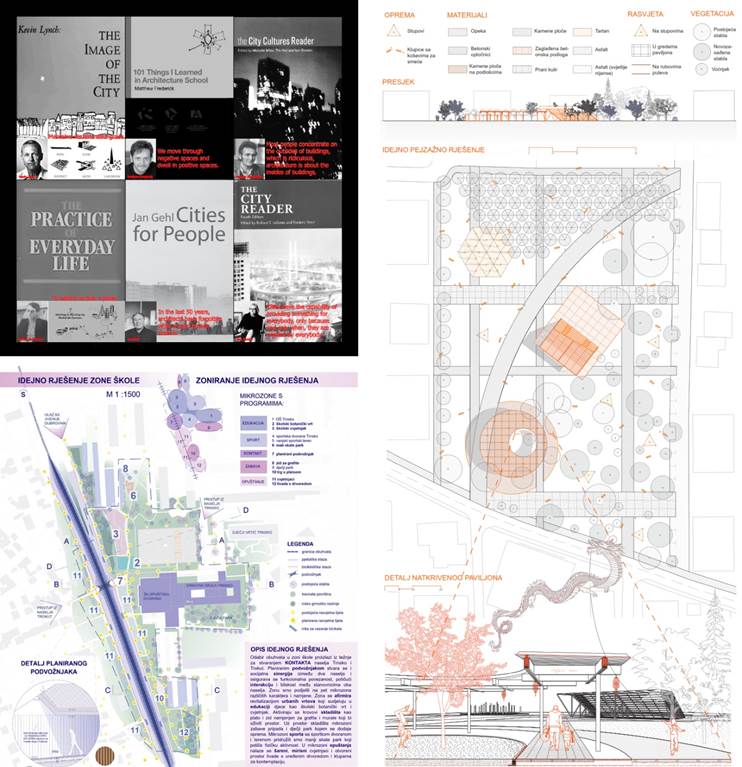
Figure 2
Results of multidisciplinary thematic blocks in student projects: A theoretical research (left top, authors: students Antonio Blaće and Karla Čavlović), B urban planning system of landscape public spaces (left bottom, authors: students Klara Ćurić and Dora Dawidowsky), C urban landscape solution for a public landscape space (right, authors: students Ivan Dujić and Ivan Duević).
Dissemination activities: exhibitions and conference participation
The dissemination of student projects has been a key component of the collaborative teaching approach (Table 4), showcasing the outcomes of interdisciplinary work in urban ecology and landscape architecture. Each year, student projects were exhibited both in conjunction with ongoing student assignments and as stand-alone events, offering local communities and wider audiences a chance to engage with the students' proposals.
Table 4
List of dissemination of student assignments and multidisciplinary teaching from 2021 until 2024 “Rethinking and (Re)Designing Open Public Spaces in New Zagreb Area”
|
Series assignment |
|
New Zagreb East
|
New Zagreb South
|
New Zagreb West
|
|
Local communities / neighbourhood |
Zapruđe, Utrina, Travno and Dugave
|
Utrina, Sopot, Siget and Trnsko
|
Kajzerica, Savski gaj, Lanište and Trnsko
|
|
|
Academic year |
2021/2022 |
2022/2023 |
2023/2024 |
|
|
Assignment aim |
Revitalisation of neighbourhoods & transformation of public spaces |
Revitalisation & reaffirmation of crucial public spaces |
(Re)connecting & transforming public spaces into places |
|
|
Assignment moto |
Heritage Revitalisation |
Community Spaces |
Slash city |
|
|
Exhibitions with lectures for students |
Zagreb Society of Architects (DAZ) 2.-11.11.2022. |
Zagreb Society of Architects (DAZ) 6.-10.11.2023. |
Zagreb Society of Architects (DAZ) 4.-8.11.2024. |
|
|
Exhibitions organised by local communities |
/
|
April 2022 Museum of Contemporary Art (MSU) 27.5.2023. |
Park Mladenaca, Q’ART 07.07.2024. |
|
|
Conferences, workshops/webinars and symposia |
Exhibition of selected 10 student posters (5 from Faculty of Architecture and 5 from Faculty of Science) with video presentation about the series assignments in New Zagreb called Urban Ecology – synergy of biology and urban planning at Science Fair, Technical Museum, Zagreb 22.–27.04.2024. |
|||
|
Round table discussion where the idea and achieved multidisciplinary collaboration was explained with introduction to new series assignment (Old New Zagreb – Ulica grada Vukovara) at DAZ 8.11.2024. |
||||
|
Lecture on the series assignments and student’s projects with discussion at Nexus Implementation: Potential and Opportunities, 05.–06.11.2024. (online conference)
|
||||
A variety of dissemination activities were organized to promote the results of the projects, as reflected in Table 4. These included:
• Exhibitions with lectures: These exhibitions presented the final student proposals alongside lectures aimed at both students and the broader public. For example, a digital pop-up exhibition of student projects on the design of public spaces in Eastern New Zagreb (Zapruđe, Utrina, Travno, Dugave) took place in 2022, opening with presentations from teaching staff and guest speakers. Similarly, exhibitions focused on the Southern New Zagreb public space proposals (Utrina, Sopot, Siget, Trnsko) were held at key venues such as the Museum of Contemporary Art (MSU) in 2023, attracting interest from local communities, city government and the general public. These exhibitions emphasized the importance of community involvement in urban design, as local representatives played an active role in presenting the student projects.
• Community-organized exhibitions: Local communities also took the initiative to organize exhibitions that highlighted specific student projects of relevance to their neighbourhoods. These events served as a platform for engaging with residents, showcasing how student work addressed local needs and challenges in public spaces.
• Conferences and workshops: Teachers and students participated in various conferences, workshops, webinars, and symposia, where the results of the student projects were presented and discussed. These events allowed for critical exchanges of ideas, fostering a reflective process that informed future assignments. The multi- and interdisciplinary nature of the projects was highlighted in these forums, with contributions from urban planners, biologists, architects, and sociologists enriching the discussions and further advancing the interdisciplinary teaching approach.
In addition to the exhibitions and community engagements, the Science Fair 2024 (Festival Znanosti 22.–27.04.2024. at Technical Museum Nikola Tesla in Zagreb) featured student works from the Urban Ecology and Design Studio III – Landscape Architecture courses. This exhibition showcased the integration of urban design principles with biodiversity conservation in New Zagreb, underscoring the importance of interdisciplinary collaboration in creating sustainable urban environments.
These activities not only promoted the results of the student projects but also facilitated valuable dialogues between students, faculty, local communities, and professional networks. The exhibitions and conferences provided a platform for sharing knowledge, receiving feedback, and fostering continued collaboration across disciplines, contributing to the development of innovative solutions for public space design in New Zagreb.
Discussion
At the University of Zagreb, Croatia, an innovative interdisciplinary approach to teaching and learning about urban design and ecology has emerged through the collaborative efforts between the Faculty of Science (Department of Biology) and the Faculty of Architecture (Department of Urban Planning, Spatial Planning, and Landscape Architecture). This collaboration, which has been increasingly shaped since 2020, brings together students from both faculties to address the multifaceted challenges of urbanization, particularly in the context of sustainable public space design. Courses such as the elective course Urban Ecology at the Faculty of Science and compulsory course Design Studio III – Landscape Architecture at the Faculty of Architecture have become platforms for multidisciplinary, interdisciplinary and transdisciplinary teaching. These courses reimagine urban public spaces in Zagreb as multifunctional community systems of places that support the diverse needs of humans, other organisms, and the environment, thereby actively contributing to the achievement of the Sustainable Development Goals.
The core aim of this work was to highlight how the collaboration between the two faculties has enabled students to engage in a comprehensive investigation of urban public spaces through project-based learning (cf. Guo et al., 2020). The outcomes of student projects not only exemplify the benefits of a multidisciplinary learning approach but also demonstrate the potential for evolving into a more integrated, interdisciplinary, and transdisciplinary framework. This shift emphasizes the need for collaborative education in addressing the urgent issues of sustainable urban development (Biberhofer & Rammel, 2017).
Evolution of the collaborative framework
The collaboration between the two faculties began with a multidisciplinary teaching approach, where students from architecture and biology engaged with a shared theme of urban ecology but studied separately within their disciplines. This allowed students to develop expertise in their respective fields while drawing on the shared theme to build connections between their knowledge. However, over time, this collaboration evolved into an interdisciplinary framework, with students working more closely across disciplines. Architecture students began exploring biodiversity and ecological concepts, while biology students examined the impact of urban design on ecosystems. This shift allowed students to learn simultaneously from multiple disciplines, creating a more integrated approach to problem-solving.
Looking ahead, the goal is to transition towards a fully interdisciplinary and transdisciplinary model, where students from various disciplines collaborate to address real-world urban ecology challenges (Biberhofer & Rammel, 2017). This approach goes beyond merely applying knowledge from different fields; it encourages students to collectively shape the learning process, integrating their diverse expertise to develop innovative solutions for complex urban problems (Biberhofer & Rammel, 2017). By fostering synergy and facilitating knowledge exchange, our collaborative educational model exemplifies how multi-, inter-, and interdisciplinary frameworks can address the multifaceted challenges of urban development, fostering the next generation of professionals equipped to tackle these issues in real-world settings.
Furthermore, multi-, inter-, and transdisciplinary approaches are essential in fostering the adoption of the sustainability agenda and the Water-Energy-Food (WEF) Nexus concept in urban planning (Sertić Perić et al., 2024). Urban areas, as key hubs for resource consumption, require designs that take into account not only WEF dimensions, but also broader ecological concerns and environmental and social dimensions, including climate change, land use, soil health, and biodiversity (Purwanto et al., 2021; Sertić Perić et al., 2024). This expanded framework, known as the WEF+ Nexus, further reinforces the importance of architecture and urban planning in urban ecology and biodiversity discussions (Sertić Perić et al., 2024). Moreover, exploring the relationship between urban design, spatial planning, and the WEF+ Nexus enables a deeper understanding of how cities can become more sustainable, resilient, and equitable in the face of contemporary challenges (Sertić Perić et al., 2024).
Multi-, inter- and transdisciplinary collaboration enhances student project quality and student engagement
The collaborative student projects presented in this work focused on enhancing the public spaces of various neighbourhoods in New Zagreb, an area in Croatian capital Zagreb undergoing rapid urban development. Over the years, the scope of these projects has expanded to address different themes, including Heritage Revitalization in Zapruđe, Utrina, Travno, and Dugave neighbourhoods, Community Spaces in Trnsko, Siget, Sopot, and Utrina neighbourhoods, and Slash City concept in Kajzerica, Lanište, Trnsko, and Savski Gaj/Trokut neighbourhoods. These projects aimed to reimagine urban spaces as sustainable and inclusive areas that support biodiversity, social integration, and community well-being.
Shaped by the interdisciplinary collaboration between faculty members (teaching staff of both faculties) and guest lecturers from diverse fields – such as urban planning, design, landscape architecture, ecology, agriculture, environmental science, and the social sciences – the student projects addressed the complexities of urbanization. These included pressing issues such as biodiversity conservation, sustainable development, and social inclusion. The integration of various disciplines enabled students to develop holistic project development approach that balanced ecological, social, and design considerations, resulting in designing public spaces that address both human needs and ecosystem health. This approach aligns with the concerns raised by urban experts, such as urban ecologists, urban planners, and sustainability professionals, who emphasize its importance for enhancing the sustainability, resilience, and vividness of urban areas (Romero-Lankao et al., 2016). By engaging with these complex urban issues, students gain valuable insights into how urban planning and ecological knowledge can inform urban/spatial planning and policy decisions, ensuring that cities are both liveable and sustainable.
The integration of multiple disciplines, such as biology (ecology) and architecture, into urban design education has been shown to significantly increase student engagement (Biberhofer & Rammel, 2017). According to studies, students in interdisciplinary programs often report higher levels of motivation and satisfaction because they are given the freedom to explore a variety of perspectives and approaches (Beane, 1997; Vincent-Lancrin et al., 2019). Research shows that when students have the freedom to select their areas of focus, they are more likely to produce innovative and original work (Winner, 2013; Vincent-Lancrin et al., 2019). This aligns with our findings at the University of Zagreb, where students have shown a high level of independence in choosing their topic (project scope) and engagement in developing collaborative projects that incorporate ecological, social, and design perspectives. Allowing students to choose topics within the broad framework fosters ownership of their projects, deepening their connection to the material and enhancing the quality of their projects (Winner, 2013). This student-centred approach was thus reflected in the high-quality work of our students, who showed a high level of engagement, but also a comprehensive understanding of urban challenges and innovative solutions to urban challenges, as evident in their final projects. For example, the projects in the Design Studio III - Landscape Architecture course required both urban and architectural designs that addressed environmental complexity and urban ecology, resulting in students developing well-defined spaces that were thought through to the technical detail. Students were challenged to integrate multiple layers into their projects to create urban systems that promote spatial and social equity, and to design functional spaces — such as squares, parks, streets, and pavilions — that are responsive to emerging needs and are buildable.
Furthermore, according to Raelin (2008), multidisciplinary teaching environments enable students to appreciate the interconnectedness of various fields and to develop solutions that are more informed and nuanced. In the case of our students, the integration of biology, urban planning, and landscape architecture in their projects allowed them to address urban public spaces in Zagreb as multifaceted systems that cater not only to human needs but also to the environment and other living organisms.
Finally, transdisciplinary education – where academic disciplines collaborate with real-world stakeholders – enhances the relevance and applicability of student work, particularly in addressing societal challenges. In transdisciplinary model, students are encouraged to work on projects that extend beyond traditional academic boundaries and engage directly with real-world issues. As some sources suggest (e.g., Budwig & Alexander, 2020; Regger et al., 2024), transdisciplinary learning encourages students to engage with problems in ways that are grounded in the complexities of society, making their learning more directly applicable to the challenges they will face in their careers. Our findings support this perspective, as students working on urban public space projects in Zagreb developed solutions that not only address ecological concerns but also consider social, cultural, and political dimensions, making their work highly relevant to sustainable urban development, addressing full complexity of urban challenges.
The continued collaboration between the Faculty of Science and the Faculty of Architecture is central to establishing this transdisciplinary framework in future courses, such as Urban Ecology and Design Studio III - Landscape Architecture. This model will deepen collaboration among students, helping them cultivate a shared understanding of how interdisciplinary knowledge can create sustainable and innovative solutions for urban environments. Through this approach, we aim to equip students with the skills and mindset necessary to navigate the complex urban challenges of the future, preparing them for careers in collaborative, interdisciplinary teams.
The role of teachers in fostering collaborative learning
Teachers play a critical role in shaping the interdisciplinary and transdisciplinary nature of courses by creating learning environments that encourage collaboration (Vincent-Lancrin et al., 2019). By collaborating across disciplines, teachers can model the integration of knowledge and provide students with unique opportunities to learn from diverse perspectives, i.e., joint teaching not only enriches the student experience but also bridges the gaps between academic disciplines, offering a more comprehensive educational approach (Budwig & Alexander, 2020; Regger et al., 2024). Our experience with the collaborative efforts between the Faculty of Science and the Faculty of Architecture at the University of Zagreb supports this finding. Student feedback collected through surveys, an integral part of the teaching evaluation process at the University of Zagreb, further reinforces this. In the survey, students expressed that the integration of different disciplines and topics, along with collaborative work with peers and faculty from other disciplines, made the lessons more engaging, enjoyable, and intellectually stimulating. They also noted that this broader perspective helped to fill gaps often found within their own specific fields of study. Additionally, students expressed pride in presenting their work at joint seminars and exhibitions, viewing these events as valuable opportunities to showcase their efforts and celebrate the collaboration between faculties.
Conclusions
In conclusion, the interdisciplinary collaboration between the Faculty of Science and the Faculty of Architecture at the University of Zagreb has proven to be a successful model for addressing the complexities of urban public space design. By integrating ecological, social, and design perspectives, students are empowered to create sustainable, inclusive, and innovative urban environments. As this collaboration continues to evolve toward a transdisciplinary model, it will better prepare students to tackle the challenges of sustainable urban development, equipping them with the skills and mindset necessary for addressing complex real-world problems.
The courses and workshops that adopt a multidisciplinary and participative pedagogical approach to urban design and landscape architecture play a key role in rethinking public spaces. These educational platforms help students engage with complex, locally specific, and socially sensitive issues, developing innovative planning strategies for the (re)design of urban spaces. By blending theory and practice, they provide students with the skills needed to address contemporary urban challenges, while fostering a deep understanding of the interconnectedness between urban development, ecological sustainability, and community well-being. Ultimately, this collaborative approach not only enhances student learning but also contributes to the creation of more sustainable, inclusive, and resilient urban environments.
The outcomes of student projects highlight the advantages of a multidisciplinary learning approach and demonstrate the potential for evolving into a more integrated, interdisciplinary, and transdisciplinary framework. This shift emphasizes the critical need for collaborative education in addressing the urgent issues of sustainable urban development.
Looking ahead, the goal is to transition to a fully transdisciplinary model where students from diverse disciplines collaborate to tackle real-world urban ecology challenges. This model encourages students to go beyond merely applying knowledge from various fields, instead collectively shaping the learning process and integrating their expertise to create innovative solutions for complex urban problems.
Exhibitions and events organized during the course create spaces for dialogue within the academic community and beyond, helping to shape the future of urban design. These platforms not only celebrate the students' work but also facilitate ongoing conversations about the evolving role of urban design in creating more sustainable and resilient cities.
Acknowledgements
We wish to thank all mentors and lecturers who together with authors of this paper participated in workshops at the Faculty of Architecture – professors: Damir Krajnik, PhD, Sanja Gašparović, PhD, Ivan Mlinar, PhD, Vedran Ivanković, PhD, Ana Mrđa, PhD, Marko Rukavina, PhD, Alen Žunić, PhD, Marija Premužić Ančić, PhD; assistants: Kristina Perkov, Marin Duić and Ines Mravunac; together with professors who participated in lectures: Jana Vukić, PhD (Faculty of Human Sciences), Sanja Bencetić and Ivana Fabrio (Design studies at the Faculty of Architecture), Tihomir Jukić, PhD, Zlatko Karač, PhD, Damir Krajnik, PhD, and Alen Kostrenčić (Faculty of Architecture).
References
Beane, J. A. (1997). Curriculum Integration: Designing the Core of Democratic Education. Teachers College Press.
Biberhofer P, & Rammel C (2017). Transdisciplinary learning and teaching as answers to urban sustainability challenges. International Journal of Sustainability in Higher Education, 18(1): 63–83.
Budwig, N., & Alexander, AJ. (2020). A Transdisciplinary Approach to Student Learning and Development in University Settings. Front Psychol. 11:576250. doi: 10.3389/fpsyg.2020.576250. PMID: 33178078; PMCID: PMC7594518.
CIHR - Canadian Institutes of Health Research (2005). Training Program Grant Guide: Strategic Training Initiative in Health Research. Ottawa: CIHR.
Creutzig, F., Urge-Vorsatz, D., Takeuch, K., Zusman, E., Aderinto, I., Sörgel, B., Ortiz Moya, F., Kumer Mitra, B., Sukhwani, V., & Salehi, P. (2024). Seeking Synergy Solutions: How Cities can Act on Both Climate and the SDGs. Expert Group on Climate and SDG Synergy. Retrieved on 10th January 2025, from https://sdgs.un.org/basic-page/seeking-synergy-solutions-four-thematic-reports-55697
Elmqvist, T., Redman, C. E., Barthel, S., & Costanza, R. (2013). History of urbanization and the missing ecology. In Elmqvist, T., Fragkias, M., Goodness, J., Güneralp, B., Marcotullio, P. J., McDonald, R. I., & Wilkinson, C. (Eds.), Urbanization, Biodiversity and Ecosystem Services: Challenges and Opportunities (pp. 13–30). Cham: Springer. doi:10.1007/978-94-007-7088-1_2
Guo, P., Saab, N., Post, L.S., & Admiraal, W. (2020). A review of project-based learning in higher education: Student outcomes and measures. International Journal of Educational Research, 102, 101586. https://doi.org/10.1016/j.ijer.2020.101586.
Karaman, Z. (2022). An Understanding of Inter and Transdisciplinary Aspects of Urban Resilience. Open Journal of Social Sciences, 10, 195-215. doi: 10.4236/jss.2022.104014.
Laszowski, E. (1994). Stari i novi Zagreb. Zagreb: Školska knjiga.
Lehmann, S. (2010). The principles of green urbanism: transforming the city for sustainability. London: Earthscan.
McPhearson, T., Karki, M., Herzog, C., Santiago Fink, H., Abbadie, L., Kremer, P., Clark, C. M., Palmer, M. I., & Perini, K. (2018). Urban ecosystems and biodiversity. In Rosenzweig, C., W. Solecki, P. Romero-Lankao, S. Mehrotra, S. Dhakal, & S. Ali Ibrahim (Eds.), Climate Change and Cities: Second Assessment Report of the Urban Climate Change Research Network (pp. 257–318). New York: Cambridge University Press.
Millennium Ecosystem Assessment (2005). Ecosystems and human well-being: Synthesis. Washington, DC: Island Press.
Mlinar, I., & Klasić, H. (2021). Zagreb Većeslava Holjevca od 1952. do 1963. – urbanistička vizija i arhitektonski dosezi. Zagreb: Muzej suvremene umjetnosti.
NSERC - Natural Sciences and Engineering Research Council of Canada (2004). Guidelines for the Preparation and Review of Applications in Interdisciplinary Research. Ottawa: NSERC.
Park, J. Y., & Son, J. B. (2010). Transitioning toward Transdisciplinary Learning in a Multidisciplinary Environment. International Journal of Pedagogies and Learning, 6(1), 82–93. https://doi.org/10.5172/ijpl.6.1.82
Purwanto, A., Sušnik, J., Suryadi, F.X., & de Fraiture, C. (2021). Water-Energy-Food Nexus: Critical Review, Practical Applications, and Prospects for Future Research. Sustainability, 13, 1919. https://doi.org/10.3390/su13041919
Raelin, J. A. (2008). Work-based Learning: Bridging Knowledge and Action in the Workplace. John Wiley & Sons.
Regeer, B.J., Klaassen, P., & Broerse, J.E.W. (2024). What Is That Thing Called ‘Transdisciplinarity for Transformation’?. In: Regeer, B.J., Klaassen, P., Broerse, J.E.W. (Eds) Transdisciplinarity for Transformation. Cham: Palgrave Macmillan. https://doi.org/10.1007/978-3-031-60974-9_1
Rieckmann, M. (2018). Learning to transform the world: key competences in education for sustainable development. Issues Trends Educ. Sustain. Dev., 39, 39–59.
Romero-Lankao, P., Gnatz, D.M., Wilhelmi, O., & Hayden, M. (2016). Urban Sustainability and Resilience: From Theory to Practice. Sustainability, 8, 1224. https://doi.org/10.3390/su8121224
Sachs, J. D. (2015). The Age of Sustainable Development. New York: Columbia University Press.
Scholz, R.W., Lang, D.J., Wiek, A., Walter, A.I., & Stauffacher, M. (2006) Transdisciplinary case studies as a means of sustainability learning. Historical framework and theory. Int J Sustain High Educ, 7, pp. 226-251.
Sertić Perić, M., Zaninović, T. & Sopina, A. (2024). Collaborative student assignments: Urban planning and ecology in Nexus-aware public spaces. Nexus Implementation: Potential and Opportunities workshop. Available info (from 19th January 2025) https://unu.edu/flores/workshop/nexus-implementation-potential-and-opportunities
Soskolne, C. (2000). Transdisciplinary approaches for public health. Epidemiology, 11:S122.
UNCTAD (2023). Handbook of Statistics 2023. Retrieved on 29th December 2024, from https://unctad.org/publication/handbook-statistics-2023
Vincent-Lancrin, S., González-Sancho, C., Bouckaert M., de Luca, F., Fernández-Barrerra, M., Jacotin, G., Vidal, J. U, & Vidal Q. (2019). Fostering Students' Creativity and Critical Thinking: What it Means in School, Educational Research and Innovation. Paris: OECD Publishing. https://doi.org/10.1787/62212c37-en
Winner, W.E. (2013). Choosing Topics. In: A Handbook for Analytical Writing. Synthesis Lectures on Professionalism and Career Advancement for Scientists and Engineers (pp. 21-28). Cham: Springer. https://doi.org/10.1007/978-3-031-02507-5_4
|
Odgoj danas za sutra: Premošćivanje jaza između učionice i realnosti 3. međunarodna znanstvena i umjetnička konferencija Učiteljskoga fakulteta Sveučilišta u Zagrebu Suvremene teme u odgoju i obrazovanju – STOO4 u suradnji s Hrvatskom akademijom znanosti i umjetnosti |
|
Urbana ekologija unutar multidisciplinarnog edukativnog okvira Urbana ekologija u okviru multidisciplinarne edukacije |
Sažetak |
|
Urbana ekologija istražuje kako živi organizmi, uključujući i ljude, međusobno utječu jedni na druge i na svoj okoliš u urbanim područjima. To je interdisciplinarno područje koje povezuje biologiju, urbanističko planiranje i druge discipline. Ovaj rad pokazuje kako su teme urbane ekologije integrirane u edukacijski okvir Sveučilišta u Zagrebu kroz pregled metodologije i rezultata suradnje studenata i nastavnika dvaju fakulteta (Prirodoslovno-matematički fakultet, Biološki odsjek i Arhitektonski fakultet, Katedra za urbanizam, prostorno planiranje i pejsažnu arhitekturu). Ova suradnja pokazuje uspješnu primjenu multidisciplinarnog pristupa u poučavanju i učenju, koji se postupno razvija u inter- i transdisciplinarni okvir, i naglašava važnost takve suradnje u rješavanju gorućih izazova održivog urbanog razvoja. Suradnja je započela u akademskoj godini 2020./2021. uvođenjem izbornog predmeta Urbana ekologija u sklopu diplomskog studija Znanosti o okolišu na Prirodoslovno-matematičkom fakultetu te njegovim sadržajnim povezivanjem s kolegijem Studio 3 - Pejsažna arhitektura, obaveznim kolegijem sveučilišnog prijediplomskog studija Arhitekture i urbanizma. Tijekom tri akademske godine (2020. - 2024.) metodologija nastave razvijala se kroz integraciju multidisciplinarnih predavanja i participativnih napora koji uključuju lokalne zajednice u proces razvoja studentskih projekata. Studentski projekti fokusiraju se na različite lokacije unutar zajedničkog urbanog konteksta, kao što su novozagrebačke četvrti, koje predstavljaju vrijedan primjer modernističkog i postmodernističkog urbanog planiranja u Zagrebu, Hrvatska. Rezultati studentskih projekata pokazuju važnost integracije urbanističkog projektiranja i ekoloških rješenja. Projekti su pokazali kako takva integracija može unaprijediti kvalitetu urbanog života i doprinijeti održivosti urbanih sredina. Uspjeh ovog okvira suradnje u skladu je s ciljevima održivog razvoja i naglašava vrijednost multi-, inter- i transdisciplinarnog pristupa u planiranju održivih urbanih rješenja. |
|
Ključne riječi: |
|
interdisciplinarnost; izložbe; javni prostor; projektno učenje; Zagreb |


